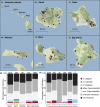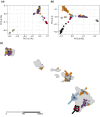Local adaptation and spatiotemporal patterns of genetic diversity revealed by repeated sampling of Caenorhabditis elegans across the Hawaiian Islands
- PMID: 35167162
- PMCID: PMC9306471
- DOI: 10.1111/mec.16400
Local adaptation and spatiotemporal patterns of genetic diversity revealed by repeated sampling of Caenorhabditis elegans across the Hawaiian Islands
Abstract
The nematode Caenorhabditis elegans is among the most widely studied organisms, but relatively little is known about its natural ecology. Genetic diversity is low across much of the globe but high in the Hawaiian Islands and across the Pacific Rim. To characterize the niche and genetic diversity of C. elegans on the Hawaiian Islands and to explore how genetic diversity might be influenced by local adaptation, we repeatedly sampled nematodes over a three-year period, measured various environmental parameters at each sampling site, and whole-genome sequenced the C. elegans isolates that we identified. We found that the typical Hawaiian C. elegans niche comprises moderately moist native forests at high elevations (500-1,500 m) where ambient air temperatures are cool (15-20°C). Compared to other Caenorhabditis species found on the Hawaiian Islands (e.g., Caenorhabditis briggsae and Caenorhabditis tropicalis), we found that C. elegans were enriched in native habitats. We measured levels of genetic diversity and differentiation among Hawaiian C. elegans and found evidence of seven genetically distinct groups distributed across the islands. Then, we scanned these genomes for signatures of local adaptation and identified 18 distinct regions that overlap with hyper-divergent regions, which may be maintained by balancing selection and are enriched for genes related to environmental sensing, xenobiotic detoxification, and pathogen resistance. These results provide strong evidence of local adaptation among Hawaiian C. elegans and contribute to our understanding of the forces that shape genetic diversity on the most remote volcanic archipelago in the world.
Keywords: Caenorhabditis; Caenorhabditis elegans; genetic diversity; local adaptation; niche.
© 2022 The Authors. Molecular Ecology published by John Wiley & Sons Ltd.
Conflict of interest statement
The authors have no conflicts of interest.
Figures







Similar articles
-
Deep sampling of Hawaiian Caenorhabditis elegans reveals high genetic diversity and admixture with global populations.Elife. 2019 Dec 3;8:e50465. doi: 10.7554/eLife.50465. Elife. 2019. PMID: 31793880 Free PMC article.
-
Large genetic diversity and strong positive selection in F-box and GPCR genes among the wild isolates of Caenorhabditis elegans.Genome Biol Evol. 2021 May 7;13(5):evab048. doi: 10.1093/gbe/evab048. Genome Biol Evol. 2021. PMID: 33693740 Free PMC article.
-
Species richness, distribution and genetic diversity of Caenorhabditis nematodes in a remote tropical rainforest.BMC Evol Biol. 2013 Jan 12;13:10. doi: 10.1186/1471-2148-13-10. BMC Evol Biol. 2013. PMID: 23311925 Free PMC article.
-
Experimental Evolution with Caenorhabditis Nematodes.Genetics. 2017 Jun;206(2):691-716. doi: 10.1534/genetics.115.186288. Genetics. 2017. PMID: 28592504 Free PMC article. Review.
-
Comparative genomics in C. elegans, C. briggsae, and other Caenorhabditis species.Methods Mol Biol. 2006;351:13-29. doi: 10.1385/1-59745-151-7:13. Methods Mol Biol. 2006. PMID: 16988423 Review.
Cited by
-
Life history in Caenorhabditis elegans: from molecular genetics to evolutionary ecology.Genetics. 2024 Nov 6;228(3):iyae151. doi: 10.1093/genetics/iyae151. Genetics. 2024. PMID: 39422376 Free PMC article. Review.
-
Genetic architecture of the response of Arabidopsis thaliana to a native plant-growth-promoting bacterial strain.Front Plant Sci. 2023 Nov 9;14:1266032. doi: 10.3389/fpls.2023.1266032. eCollection 2023. Front Plant Sci. 2023. PMID: 38023938 Free PMC article.
-
Transposon-mediated genic rearrangements underlie variation in small RNA pathways.Sci Adv. 2024 Sep 20;10(38):eado9461. doi: 10.1126/sciadv.ado9461. Epub 2024 Sep 20. Sci Adv. 2024. PMID: 39303031 Free PMC article.
-
Getting around the roundworms: Identifying knowledge gaps and research priorities for the ascarids.Adv Parasitol. 2024;123:51-123. doi: 10.1016/bs.apar.2023.12.002. Epub 2024 Feb 20. Adv Parasitol. 2024. PMID: 38448148 Free PMC article.
-
Behavioral adaptations of Caenorhabditis elegans against pathogenic threats.PeerJ. 2025 Apr 14;13:e19294. doi: 10.7717/peerj.19294. eCollection 2025. PeerJ. 2025. PMID: 40247835 Free PMC article. Review.
References
-
- Alison Kay, E. (1994). A natural history of the Hawaiian Islands: Selected Readings II. University of Hawaii Press. https://market.android.com/details?id=book‐SFLoKRq‐joEC
Publication types
MeSH terms
LinkOut - more resources
Full Text Sources

